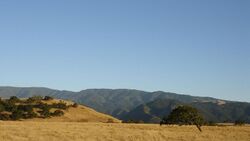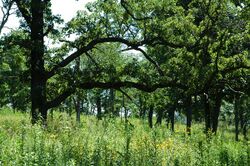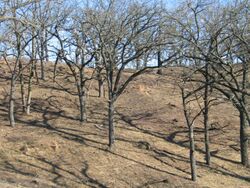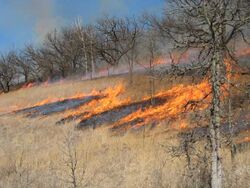Earth:Oak savanna
An oak savanna is a type of savanna—or lightly forested grassland—where oaks (Quercus spp.) are the dominant trees. The terms "oakery" or "woodlands" are also used commonly, though the former is more prevalent when referencing the Mediterranean area.[1] These savannas were maintained historically through wildfires set by lightning, humans, grazing, low precipitation, and/or poor soil.
In the USA
Although there are pockets of oak savanna almost anywhere in North America where oaks are present, there are three major oak savanna areas: 1) California, British Columbia, Washington and Oregon in the west; 2) Southwestern United States and northern Mexico; and 3) the prairie/forest border of the Midwestern United States.[2][3] There are also small areas of oak savannas in other parts of the world. (See also Eastern savannas of the United States for information on pine savannas of the U.S. South.)
thumb|Fox River Grove, Illinois oak savanna; winter
Midwestern oak savannas
The oak savannas of the Midwestern United States form a transition zone between the arid Great Plains to the west and the moist broadleaf and mixed forests to the east. Oak savannas are found in a wide belt from northern Minnesota and southern Wisconsin, down through Iowa, Illinois, northern and central Missouri, eastern Kansas, and central Oklahoma to north-central Texas, with isolated pockets further east around the Great Lakes including Ontario.[4] The bur oak (Quercus macrocarpa) is the dominant species in northern oak savannas, although black oak (Quercus velutina), white oak (Quercus alba), and Hill's oak (Quercus ellipsoidalis) are sometimes present. The dominant tree in the south is usually black oak, although the chinquapin oak (Quercus muhlenbergii), post oak (Quercus stellata), and black-jack oak (Quercus marilandica) are also common. The flora of the herbaceous layer generally consists of species associated with tallgrass prairies, both grasses and flowering plants, although some woodland species may be present. There are also a few species that are unique to oak savannas.[5][6][7] Oak savannas, because of their mixture of grassland, woodland, and unique savanna species, typically have a higher plant diversity than grasslands and woodlands combined.
History
Before European settlement, the oak savanna, a characteristic fire ecology, was extensive and was often a dominant part of the ecosystem. Fires set by lightning ensured that the savanna areas did not turn into forests. Savannas normally were found next to large prairies near rolling hills and this combination of habitat was perfect for deer, bison, elk, and other grazing animals.[8] Only trees with a high tolerance for fire, principally certain oak species, were able to survive. On sandy soils, black oak (Quercus velutina) predominated. On rich soils bur oak (Quercus macrocarpa) was the major tree in Midwestern North America. These savanna areas provided habitat for many animals, including American bison, elk, and white-tailed deer.
The most fire-tolerant of the oak species is the bur oak (Quercus macrocarpa), which is especially common in hill-country savannas in the Midwest.
European settlers cleared much of the savanna for agricultural use. In addition, they suppressed the fire cycle. Thus surviving pockets of savanna typically became less like savannas and more like forests or thickets. Many oak savanna plant and animal species became extinct or rare.
Restoration
With the rise in interest in environmental conservation, restoration and preservation of surviving areas of oak savanna began. Low intensity, spring prescribed burns have been used since 1964 at the Cedar Creek Ecosystem Science Reserve in Minnesota in an attempt to restore the area to an oak savanna.[9] Burned areas are now more savanna like (having greater grass and forb and lower shrub and lower tree representation) than unburned areas but still have higher overstory densities than apparently existed in presettlement times. Restoration work began in the 1970s in Illinois, followed by work in Wisconsin, Indiana, Iowa, Missouri, and Minnesota.[10] The Bald Hill Natural Area in Corvallis, Oregon was established in the 1990s in part to protect oak savanna remnants.[11][12] At one point in time the oak savanna was the most common type of vegetation found in the midwest, but it is now endangered with many ecologists every year working on replacing the oak savannas that have been destroyed in the past.[13]
Current distribution
Presettlement there was approximately 50,000,000 acres of oak savanna in Midwestern United States, all of it being exclusively in a wide strip stretching from southwestern Michigan to eastern Nebraska and from southern Manitoba to central Texas. After Europeans arrived, fire suppression and settlement diminished the oak savannas to a fraction of their former expanse, which currently exist in many fragmented pockets throughout its native range. Many sites are protected and maintained by government bodies or non-profit organizations such as The Nature Conservancy, the Wisconsin and Minnesota Departments of Natural Resources, and the Iowa Natural Heritage Foundation. In the midwest, about only 30,000 acres total of oak savanna still exist. The savannas that remain are fairly small at about 100 acres and this rarity has caused them to be categorized as “globally imperilled”.[13] It is estimated that about only less than 0.02% of the original savannas remain due to human interaction and many organizations and conservations are prioritizing restoring and recreating these ecosystems in the midwest.[8]
Examples of remnant oak savanna include:
- Neal Smith Wildlife Refuge near Prairie City, Iowa.
- Indiana Dunes National Park in Indiana.
- Hobart Nature District in Hobart, Indiana.
- Numerous State Natural Areas in Wisconsin.
- Lake County Forest Preserve District in Illinois.
- Waterfall Glen Forest Preserve near Darien, Illinois.
- Cook County Forest Preserve District and Iroquois County State Wildlife Area in Illinois.
- Oak Openings Preserve Metropark in Ohio.
- Pinery Provincial Park on Lake Huron in Ontario, Canada.
Examples of restored oak savanna sites:
- Indiana's Conrad Savanna Nature Preserve in north Newton County.[14]
- Oak savanna restoration project site on Winchell Trail in Minneapolis, Minnesota[15]
- Wisconsin's Pleasant Valley Conservancy State Natural Area.[16]
- Minnesota's Belwin Conservancy.[17]
In the Western Palearctic
In Europe, wood pastures, semi-open oak woodlands used for grazing, were widespread and common landscape features across the continent during the Middle Ages, but have since declined. Traditionally, they have been considered purely anthropogenic landscapes, the result of human clearing of virgin forest since the beginning of the European Neolithic. However, according to proponents of the controversial wood-pasture hypothesis, they can be viewed as functional analogs to the oak savannas that may have naturally covered large parts of Europe during the early Holocene. After the Industrial Revolution and the accompanying intensification of land use, they became rarer and were displaced by forests, open croplands, pastures, and meadows. Today, they are largely confined to small patches in western and central Europe, while intact forest pastures are still found in eastern Europe, especially Romania. In the Mediterranean region, oak savannas are still widespread, especially on the Iberian Peninsula.[18]
In the Mediterranean
In the Western Mediterranean, oak savannas, known as dehesas in Spanish and montados in Portuguese, are at present widespread, concentrated in Southern Portugal, the Extremadura and Andalusia. They are actively managed and used for the production of cork and as pastures for Spanish fighting bulls and the black Iberian pig for the production of Jamón ibérico, among other uses. The main tree components are ballota oak (Quercus rotundifolia) and cork oak (Quercus suber), but Portuguese oak (Quercus faginea) and Pyrenean oak (Quercus pyrenaica) may also be common.[18] Other oak species found in the area include Mirbeck's oak (Quercus canariensis), downy oak (Quercus pubescens), pedunculate oak (Quercus robur), sessile oak (Quercus petraea), Quercus estremadurensis, Quercus × cerrioides, kermes oak (Quercus coccifera) and Lusitanian oak (Quercus lusitanica).
In the Eastern Mediterranean, oak rangelands are still common landscape elements in Greece, Anatolia and the Levant.[18] They are formed by a number of oak species, including pedunculate oak (Quercus robur), sessile oak (Quercus petraea subsp. polycarpa), downy oak (Quercus pubescens), Hungarian oak (Quercus frainetto), Quercus dalechampii, Strandzha oak (Quercus hartwissiana), Austrian oak (Quercus cerris), Macedonian oak (Quercus trojana), holly oak (Quercus ilex), Kasnak oak (Quercus vulcanica), Aleppo oak (Quercus infectoria), Lebanon oak (Quercus libani), Tabor oak (Quercus ithaburensis), Valonia oak (Quercus ithaburensis subsp. macrolepis), Brant's oak (Quercus brantii), Quercus aucheri, Quercus look and kermes oak (Quercus coccifera).
See also
References
- ↑ Aronson, James; Pereira, João Santos; Pausas, Juli G. (26 September 2012). Cork Oak Woodlands on the Edge: Ecology, Adaptive Management, and Restoration. Island Press. ISBN 9781610911306. https://books.google.com/books?id=z-ND18cujaUC&q=corkoak+savanas&pg=PA20.
- ↑ McPherson, Guy R. (2023-01-10). Ecology and Management of North American Savannas. University of Arizona Press. doi:10.2307/j.ctv34h09q6. ISBN 978-0-8165-5243-6. http://www.jstor.org/stable/10.2307/j.ctv34h09q6.
- ↑ Anderson, Roger C., ed (1999-07-28). Savannas, Barrens, and Rock Outcrop Plant Communities of North America (1 ed.). Cambridge University Press. doi:10.1017/cbo9780511574627. ISBN 978-0-521-57322-1. https://www.cambridge.org/core/product/identifier/9780511574627/type/book.
- ↑ Nuzzo, Victoria A. (1986). "Extent and Status of Midwest Oak Savanna: Presettlement and 1985". Natural Areas Journal 6 (2): 6–36. ISSN 0885-8608. https://www.jstor.org/stable/43910878.
- ↑ Penfound, W.T. (1962). "The savanna concept in Oklahoma". Ecology 43 (4): 774–775. doi:10.2307/1933481.
- ↑ Abrams, M.D. (1992). "Fire and the development of oak forests". BioScience 42 (5): 346–353. doi:10.2307/1311781.
- ↑ Packard, Steve (1988-06-20). "Chronicles of Restoration: Just a Few Oddball Species: Restoration and the Rediscovery of the Tallgrass Savanna" (in en). Ecological Restoration 6 (1): 13–22. doi:10.3368/er.6.1.13. ISSN 1543-4060. https://er.uwpress.org/content/6/1/13.
- ↑ 8.0 8.1 Dey, Daniel. "Restoration of Midwestern Oak Woodlands and Savannas". https://www.fs.fed.us/nrs/pubs/jrnl/2015/nrs_2015_dey_001.pdf.
- ↑ Jakes, P. (2006) (in en). Forestry cooperatives: what today's resource professionals need to know. Proceedings of a satellite conference; 2003 November 18 (Report). doi:10.2737/NC-GTR-266. https://www.nrs.fs.usda.gov/pubs/gtr/gtr_nc266.pdf.
- ↑ Stevens, William K.; Wynne, Patricia J. (1996-05-01) (in English). Miracle Under the Oaks: The Revival of Nature in America. Gallery Books. ISBN 978-0-671-78045-6.
- ↑ "Bald Hill Park". https://traveloregon.com/things-to-do/bald-hill-park/.
- ↑ "Bald Hill Natural Area". https://www.corvallisoregon.gov/parksrec/page/bald-hill-natural-area.
- ↑ 13.0 13.1 "Oak Savannas : characteristics, restoration and long-term management". https://www.oaksavannas.org/.
- ↑ "Conrad Station Savanna" (in en-US). https://www.nature.org/en-us/get-involved/how-to-help/places-we-protect/conrad-station-savanna/.
- ↑ "Restoration Resource Center USA: Minnesota: Oak Savanna Restoration along an Urban River". https://www.ser-rrc.org/project/usa-minnesota-oak-savanna-restoration-along-an-urban-river/.
- ↑ "Pleasant Valley Conservancy". http://pleasantvalleyconservancy.org.
- ↑ "Belwin Conservancy". https://belwin.org/.
- ↑ 18.0 18.1 18.2 Hartel, Tibor, ed (2014). European Wood-pastures in Transition. Routledge. ISBN 978-0-8153-9531-7.
External links
- "Upper Midwest forest-savanna transition". Terrestrial Ecoregions. World Wildlife Fund. http://worldwildlife.org/ecoregions/na0415.
- "Central forest-grasslands transition". Terrestrial Ecoregions. World Wildlife Fund. http://worldwildlife.org/ecoregions/na0804.
- Oak Savannas: Characteristics, Restoration, and Long-Term Management
- Pleasant Valley Conservancy State Natural Area (Wisconsin)
- Oak Savannah Documentary produced by Oregon Field Guide
 |







